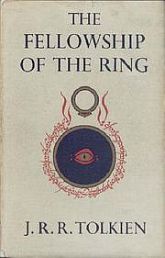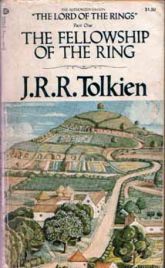Ideally one should write about the three books of The Lord of the Rings as a unit, since that’s the way J.R.R. Tolkien wrote them. It was the publisher’s decision to split the novel into three parts, a decision that the author only grudgingly accepted. He wanted LOTR published in six parts, with book 1 called The Return of the Shadow, and book 2 called The Fellowship of the Ring.
 But more importantly, in an ideal world one would be able to discuss The Fellowship of the Ring without being overshadowed by Peter Jackson’s film of the same name. Unfortunately, for me that’s impossible. I’ve seen the films probably a dozen times each since their release, enough that I can recite most of the dialogue word for word. The Extended Edition of Fellowship is one of my favorite films ever, ever, ever.
But more importantly, in an ideal world one would be able to discuss The Fellowship of the Ring without being overshadowed by Peter Jackson’s film of the same name. Unfortunately, for me that’s impossible. I’ve seen the films probably a dozen times each since their release, enough that I can recite most of the dialogue word for word. The Extended Edition of Fellowship is one of my favorite films ever, ever, ever.
But this is the first time I’ve re-read Tolkien since the film’s release, so I was constantly reacting to things that were different from what I’m used to — as if the books were the adaptation of the films and not the other way around. And in case that’s not irritating enough, I couldn’t picture anyone but Viggo Mortensen and Elijah Wood as Aragorn and Frodo, while Ian McKellen’s voice kept ringing out whenever Gandalf opened his mouth. It’s kind of like reading those annoying New Testament Bibles where Jesus’s words are printed in red; every snippet of dialogue that was used in the films stands out.
It’s especially a nuisance when you consider that J.R.R. Tolkien and Peter Jackson had vastly different agendas. Jackson made wonderful films in their own right. But they’re distinctly different in tone from the books, and I’m convinced now that Tolkien himself would have hated them.
What’s the difference? Take just one example, the battle with the orcs and the cave troll in the mines of Moria. Jackson lavishes plenty of attention on the battle, with multiple decapitations, thrown swords, close escapes, and a (somewhat clunky) CGI troll that vexes the Fellowship for a good ten minutes. But in the book, here’s how Tolkien describes that battle:
The affray was sharp, but the orcs were dismayed by the fierceness of the defence. Legolas shot two through the throat. Gimli hewed the legs from under another that had sprung up on Balin’s tomb. Boromir and Aragorn slew many. When thirteen had fallen the rest fled shrieking, leaving the defenders unharmed, except for Sam who had a scratch along the scalp.
There are a few more paragraphs describing the setup and denouement, but you can tell that Tolkien’s heart isn’t in it. The entirety of the scene that Jackson spends fifteen minutes on is a single page of Tolkien’s manuscript.
In fact, I was stunned to discover that all of the action sequences that thrilled me as a kid are really much, much shorter than I had remembered. The flight to the Ford? A measly 2 1/2 pages. Gandalf’s confrontation with the Balrog? 2 1/2 pages. Frodo’s fight with the Nazgûl near Weathertop? One page. And just think of all the dramatic sequences that Tolkien either doesn’t describe at all or relegates to a character’s secondhand report:
- Gandalf’s confrontation with Saruman and escape from Orthanc
- Gandalf’s battle with the Black Riders on Weathertop
- Gollum’s escape from Mirkwood
- The Black Riders’ incursion into Bree
- The elves’ battle with the orcs inside Lothlórien
- Boromir’s last battle with the orcs
- Glorfindel’s attack on the Nazgûl at the Ford
And that’s all just in Fellowship. The issue will become even more pronounced in The Two Towers, when Tolkien chooses to sit out the ents’ attack on Isengard.
 The fact of the matter is that J.R.R. Tolkien has no taste for blood. He goes out of his way to avoid describing action sequences by keeping the action offstage. As soon as the swords are drawn, the authorial voice recedes and becomes distant summarization. And the summarization itself? Well, it’s not clear to me from the text that Tolkien knows anything at all about sword fighting or horse riding or archery; his descriptions don’t contain any specialized knowledge outside the imagination of your average 14-year-old. Certainly Tolkien doesn’t know swords the way George R.R. Martin knows armor, for instance, or the way Stephen Hunter knows guns.
The fact of the matter is that J.R.R. Tolkien has no taste for blood. He goes out of his way to avoid describing action sequences by keeping the action offstage. As soon as the swords are drawn, the authorial voice recedes and becomes distant summarization. And the summarization itself? Well, it’s not clear to me from the text that Tolkien knows anything at all about sword fighting or horse riding or archery; his descriptions don’t contain any specialized knowledge outside the imagination of your average 14-year-old. Certainly Tolkien doesn’t know swords the way George R.R. Martin knows armor, for instance, or the way Stephen Hunter knows guns.
So if Tolkien doesn’t care about the action sequences, what does he care about?
Consider this: in my edition of The Fellowship of the Ring, the Council of Elrond is 33 pages long. Gandalf’s infodump to Frodo in “The Shadow of the Past” stretches for about 17 pages. There must be at least 20 solid pages of verse interlaced throughout the book.
It’s clear that what Tolkien adores is the act of storytelling. The book is full of it. Every five pages, it seems, the characters are sitting down around a fire to recount old history or sing a narrative song. Sometimes it seems like the entire Lord of the Rings is just a framework for Tolkien to hang the folk tales, myths, and poems on.
But not only are the characters always telling stories; they’ve got this strange postmodern awareness about their own story in progress. Sam says to Haldir in Lothlórien: “I feel as if I was inside a song, if you take my meaning.” Aragorn is often compared to the verses Bilbo has composed about him (“All that is gold does not glitter / Not all those who wander are lost”). Bilbo is constantly talking about how he’s going to write everything down in his book, causing Frodo and Sam to wonder several times what their story’s going to sound like when it’s set down on paper.
It might sound like I’m complaining about The Fellowship of the Ring — but I’m not. The most astonishing thing I discovered on re-reading the book is how incredibly good Tolkien is at the fundamentals of storytelling. His pacing is absolutely perfect, which as a published author I can tell you is very difficult to accomplish. He’s always very careful to properly foreshadow things that need foreshadowing. Alfred Hitchcock knew that the scariest things are the ones you don’t see onscreen, and Tolkien follows this rule to the letter (see above). He builds up a slow but persistent tension and menace of the unseen.
And his prose is better than I had remembered in most places, though surprisingly it’s not nearly as divergent in tone from The Hobbit as I had thought. The poetry, however, doesn’t stand up so well. Even Tolkien’s verses about the most sublime subjects are too heavy handed on the meter and rhyme. They all sound like limericks about a man from Nantucket.
(Tolkien also has the irritating habit of switching point of view whenever it suits him. Out of the blue, the omniscient narrator will jump into Gandalf’s or Aragorn’s head for a moment to show the reader their thoughts. Then in the next moment, their actions and motivations are shrouded in secrecy, leaving the reader to wonder what’s going on. Not a hanging offense, but sloppy writing nonetheless.)
 But the place where Tolkien really falls down on the job is in characterization. Most of the time, he’s far more interested in lingering on the details of the terrain and the architecture. (J.R.R. might not have known sword fighting, but man, did he know his trees. Ever notice that there are only four forests on the map of Middle Earth, and through the course of LOTR and The Hobbit, we spend time in them all?)
But the place where Tolkien really falls down on the job is in characterization. Most of the time, he’s far more interested in lingering on the details of the terrain and the architecture. (J.R.R. might not have known sword fighting, but man, did he know his trees. Ever notice that there are only four forests on the map of Middle Earth, and through the course of LOTR and The Hobbit, we spend time in them all?)
Frodo, Sam, and Gandalf are wonderfully realized characters, but Merry and Pippin are scarcely distinguishable at all in Fellowship. Legolas and Glorfindel might well have been named Anonymous Elves #23 and #24. When he does indulge in character description, Tolkien mostly doles out rather useless flowery aphorisms. Take his description of Elrond:
The face of Elrond was ageless, neither old nor young, though in it was written the memory of many things both glad and sorrowful… Venerable he seemed as a king crowned with many winters, and yet hale as a tried warrior in the fulness of his strength.
Then there’s the Balrog, which he describes thusly:
[I]t was like a great shadow, in the middle of which was a dark form, of man-shape maybe, yet greater; and a power and terror seemed to be in it and to go before it… Its streaming mane kindled, and blazed behind it. In its right hand was a blade like a stabbing tongue of fire; in its left it held a whip of many thongs.
Er, thanks. That helps a lot. Try putting those descriptions in your next short story, and watch everyone in the workshop roll their eyes.
Characterization is actually one thing that Peter Jackson’s films did better than the books — and I think that’s the real reason behind the films’ success. Aragorn, in particular, gets some much-needed humanization. I’m not sure why the author chose to relegate the love story with Arwen to the marginalia in the back of The Return of the King, but without it we’re frequently robbed of much-needed context for Aragorn’s decisions. Boromir too is given short shrift by Tolkien, but the combination of the script and Sean Bean’s superb acting truly make him come alive. And Saruman, of course, is given an actual role in the films, while in the books he just makes a few choice cameo appearances.
So one-third of the way through, I can definitely say that re-reading The Lord of the Rings has been an eye-opening experience. I can’t wait to dig in to The Two Towers.